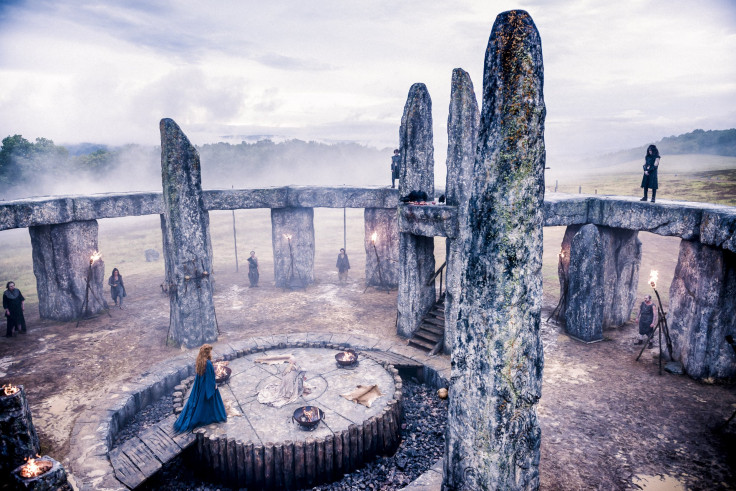'Britannia': Find out the real history behind the TV series

The first season of “Britannia” showed the warriors from Rome invading the lands of the druids. But what is the real history behind the story? To shed some light on the actual history of Britain, Professor Carole Cusack, an expert in Religious Studies, European Mythology and Contemporary Religious Trends at the University of Sydney, spoke to International Business Times Australia and shared her insight.
International Business Times Australia: What was the real reputation of Britain in the old days? The TV series shows how people outside feared this land as a place of magic, demons and human flesh-eaters.
Professor Carole Cusack: Britain was remote from Rome and to reach it, ships had to sail outside of the Mediterranean Sea through the Pillars of Hercules (two promontories on either side of the Straits of Gibraltar). The name “Mediterranean” means the middle of the earth, so we know the Romans thought to sail out of the sea they also called the mare nostrum (“our sea”) meant to leave the centre and to journey towards the end of the earth. Britain was an island off the coast of the European continent, and people speculated on the wild people who lived there. The Romans had conquered the Gauls and the Belgae, who were also Celtic peoples, and they had read Greek authors who had described Celtic culture in detail. Celts were known to be head-hunters, to offer human sacrifices, and to be fearless fighters (the women as well as the men).
IB Times: The Celtic stones have always captured the imagination of writers. What do we know for sure about these stones?
Cusack: The first thing we know is that the stone circles that are constructed all over Britain (there are more than one thousand, from famous examples like Stonehenge and Avebury, and less well-known but equally impressive Stanton Drew and Callanish) were NOT constructed by the Celts. They were built in the Neolithic (New Stone Age) era, and we do not know the language or ethnicity of the peoples who lived in Britain in 3000 BC. It may be that the monuments were used by the Druids (as the most important structures in Britain and Ireland).
There are other monuments apart from stone circles; great passage graves (like Newgrange and Knowth in Ireland), chambered tombs (like Maes Howe in Orkney), individual standing stones and small groups (like the King Stone and the Whispering Knights at Great Rollright), and dolmens (like Carwynnen Quoit in Cornwall). The association of the Druids with the stone monuments was established by antiquarians from the 16th to the 18th centuries, men like William Stukeley and John Wood of Bath, who speculated on who might have built Stonehenge. Without any proper knowledge, some people even thought the Romans had built the monuments.
IB Times: What was the prominent religion in Britain during this time? Can you briefly share details about some of their rituals?
Cusack: There is not a great deal of information about the British Celts and their religion. The Druids had an academy or training college on the island of Mona (which is Anglesey in north Wales). The Celts had sacred groves in which sacrificial rituals took place. There are British Pagan sacred sites that have been identified. Many are wells or water sources, like the Well of Coventina on Hadrian’s Wall, and the sanctuary of the king-god Nodens at Lydney Park at Gloucester. That shrine is interesting as the well contained curse tablets, statues of body parts that mark it out as a healing site, and evidence of sacred dogs being kept there. The Celtic goddess Sulis, whom the Romans identified with Minerva, patron of the arts, warfare, healing and wisdom, was worshipped at Aquae Sulis (Bath). Other deities include Andraste (goddess of war) and Brigantia (patron of the Brigantes, a powerful British tribe).
IB Times: What was the invasion of Roman General Aulus Plautius actually like? How was it different from the invasion of Julius Cesar?
Cusack: Caesar first came to Britain in 55 BC but did not attempt conquest. His second visit in 54 BC was launched from Gaul – where his armies were fighting the Gallic tribes – and the fleet reached Pegwell Bay in Kent on 5 July. Caesar did not leave a standing legion, and did not attempt to secure the land, but rather made treaties with sundry royal families so that he could return to Gaul. He eventually defeated the Gauls under the chieftain Vercingetorix in the battle of Alesia in 52 BC. When Claudius sent four legions under the command of Aulus Plautius in 43 AD the intention was conquest and to turn Britannia into a province of the Empire. Aulus was commander only till 47 AD. The commander from 59-61 AD Suetonius Paulinus attacked and destroyed the Druid sanctuary on Mona. The Romans set up frontiers (Exeter to the Humber along the Fosse Way, later Hadrian’s Wall, then the Antonine Wall which runs through Falkirk in Scotland, which was the farthest north the Romans got). Key allies include Cartimandua, Queen of the Brigantes, and key enemies include Boudicca, Queen of the Iceni, so women were prominent in Celtic politics.
"Britannia" Season 1 is available now on Blu-ray and DVD.





















